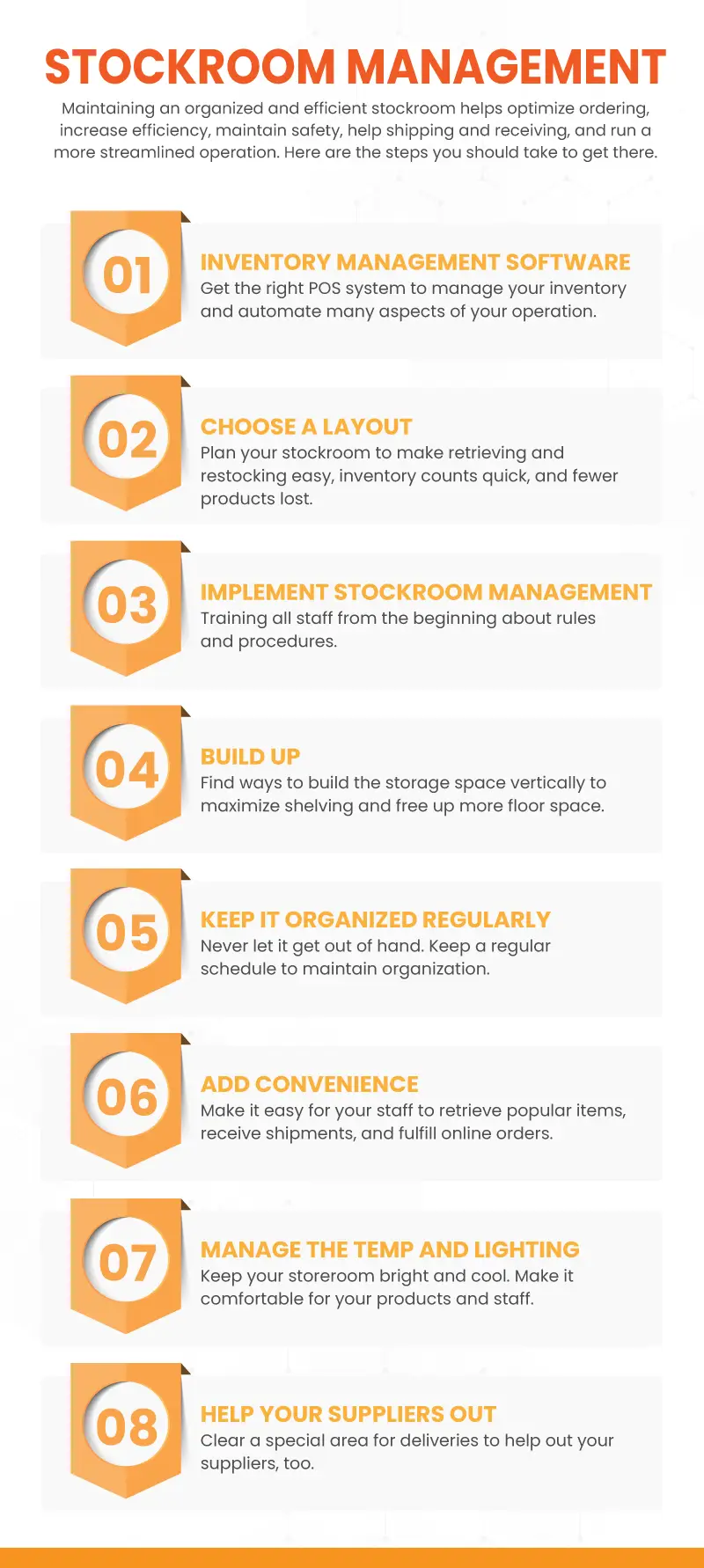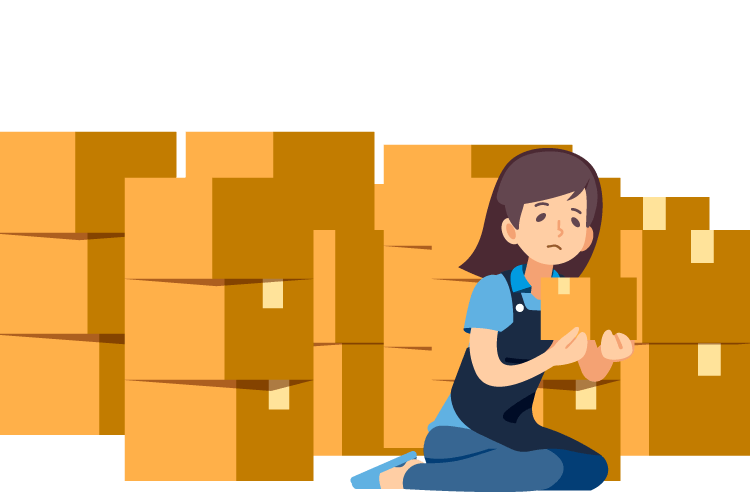Running a small business requires a whole lot of organization. From your taxes and budget management to your loyalty program and employee scheduling, there are a lot of pieces to figure out.
One area that is often overlooked is stockroom management. It’s critical to keep track of your inventory from the supplier order to the final sale. In fact, poor inventory management cost retailers approximately $1.75 billion according to a 2015 study that investigated preventable returns, stockouts, and overstocks.
Using powerful inventory management software is a big part of the battle, but it’s also important to keep a clean and organized stockroom.
Stockroom management helps businesses know exactly where products are, keep an accurate count on all items, free up space for new orders, and reduce stressful clutter. Even for small spaces, there are ways to organize a retail stockroom that can transform how you conduct your day-to-day business.
Just as you meticulously planned your retail store layout, great planning of your warehouse space and stockroom is critical, too. Below are some simple ways to keep your inventory in order and improve your stockroom management.

1. Get an Inventory Management System
We can get the most important one out of the way first. Getting a reliable POS system with inventory management features is essential for most retail stores, particularly if you have a warehouse or stockroom.
An inventory management system can do so much to improve your daily and long-term operations. It can automate ordering, optimize order levels, send notifications, communicate with vendors, transfer stock, and manage franchises.
Starting with a proper inventory system will help you better understand your products and, therefore, better organize your stock on hand on your shelves and in your stockroom. Better organization means that you’ll more easily have the right amount of inventory on hand at any given time. This level of stock management is so important for keeping your shoppers happy by having everything they need and your capital and stockroom space freed up by not ordering too much.
2. Choose a Stockroom Layout
Aside from your inventory management software, the initial planning and layout of your stockroom is probably the most important item on the list.
A good stockroom layout will help your store succeed on a number of levels:
- Improved efficiency for restocking shelves
- More accurate and timely inventory counts
- Fewer lost products
- Reduced shrinkage from product damage
- Less stressed employees
- Better aesthetics for any guests who see the stockroom
Start by planning the basic rows and columns of the warehouse or stockroom. Map out where you’ll add shelving, desks, cabinets, drawers, and boxes. You’ll want to add storage space that will easily fit the size of inventory you receive from suppliers.
Also, leave additional space initially. You want to leave some room for error in case you’re forgetting something. Plus, your business may scale down the road, in which case you’ll need extra storage in your stockroom.
Some businesses should look into adding mobile storage, too. This provides more flexibility for ebbs and flows to your ordering throughout the year. Storage space is expensive but it’s important to find solutions to ensuring that you always have an adequate amount of space for your products.
3. Implement Stockroom Management Rules and Training
From the beginning, set up strict rules for your stockroom. And training all new staff members accordingly. Like other aspects of keeping your business organized, a uniform policy helps keep workplace procedures simple and straightforward. Even if some rules seem over the top or unnecessary, it’s better to err on the cautious side.
When creating your stockroom policies, prioritize safety. It’s vital that your team has a safe space to work in at all times.
But also implement rules that will promote cleanliness, organization, and efficiency. Most retailers opt to ban food and drink in the stockroom. Add some cameras in the back to make sure that people are behaving appropriately and keeping it a safe area of your store.
4. Build It Vertically
Just like retailers that have limited space in their shopping areas, it’s important to build warehouse storage vertically. Add shelves along all open walls and build well-spaced rows that can be built up if additional space is needed in the future.
Still, you need to be sure that it’s safe and convenient. It’s important that your team members can access all products quickly and securely. And this should include people of all heights. Add stools and ladders if necessary. Check with your city to ensure they’re up to safety codes, and ask your staff if they’re all comfortable using the equipment.
5. Organize Your Stockroom Regularly
Even a small stockroom can get out-of-hand within days. And an out-of-hand stockroom means your business won’t be running at peak capacity. So it’s vital that you implement a system that keeps it organized and cleaned regularly.
Depending on your product line, keep items sorted logically. Use different bins for various colors, sizes, brands, suppliers, etc. – whatever makes sense to you and your team.
Whatever the system, label all items clearly. Put rules in place, and delegate scheduled tasks to your staff. A well-organized stockroom keeps business running smoothly and also protects you from petty internal theft and retail fraud.
6. Make It Convenient to Reach Top Products
You want your team to be in and out of the stockroom as quickly as possible. Oftentimes, they’re back there to grab a product for a waiting customer or to restock shelves that are low in inventory. Either way, there is typically some urgency to the situation.
So make it easy for them. Plan your product layout so that similar items are grouped together in a logical way. Add the most commonly retrieved items conspicuously near the front of the room so your team members can keep moving quickly.
7. Manage the Stockroom Climate and Lighting
Some retailers will require far more sensitive climate control and lighting than others. People who run museums and open wine shops, for instance, need to be extra cautious about keeping their stockrooms at specific temperatures and lighting levels throughout the year.
Though other retail small businesses won’t need that attention to detail in this department, it’s still important to monitor these two items.
Keep the temperature manageable for your team that has to work back there. A hot stockroom or warehouse makes for a miserable working environment. And if you operate in a humid region, add a dehumidifier in addition to your A/C – humidity can damage your packaging and products.
As far as retail store equipment, lighting is also important. You should focus on setting up a system that makes it easy to find items and maintain an appropriate level of safety. Bright lights make it easier to find items and watch one’s footing. Plus, there will inevitably be less lost in the back corners of your stockroom.
8. Make Shipping and Receiving Easy
Lastly, pay some attention to your shipping and receiving areas. Most brick and mortar retailers will have more products coming in than shipping out. But with more running an eCommerce side to their business in addition to their physical location, it’s important to plan for a designated space to ship out, too.
Make it convenient for any delivery people to unload and stack boxes. Not only do you want to make their lives easier, but you also want to ensure that your products aren’t being damaged in the arrival process.
How to Organize a Retail Stockroom with KORONA POS
To learn more about how to manage your inventory as a whole, check out KORONA POS. The vast inventory management POS features are truly second to none. We’ll help your business make sense of your product line and get your retail store in order.
Better yet, you can try it all out free of charge. Create an account below and start uploading your product data. One of our product specialists will walk you through each feature so you can see how it will transform your business and help you scale.
Get started with KORONA POS today!
Explore all the features that KORONA POS has to offer with an unlimited trial. And there’s no commitment or credit card required.












